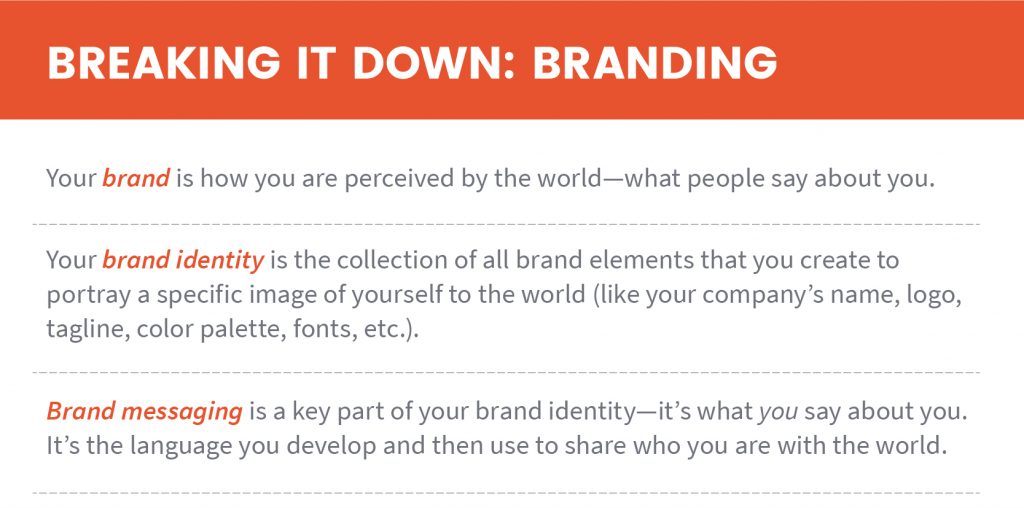When you think about your brand identity, what comes to mind? Your logo? Tagline? Sure, these are two important components, but there’s much more to an effective brand identity—including messaging.

Let’s take a closer look at brand messaging, an often overlooked component of a brand identity.
What Is Brand Messaging?
Brand messaging is the foundation that guides the development of all of your written and spoken marketing communications (such as your website, ads, print collateral, social media, new business pitches, and so on). It’s internally agreed-upon language that conveys your business’s value and differentiators.
Anyone who writes or speaks on behalf of your company should do so while guided by your brand messaging. Consistency is key. If you disseminate varying or contradictory messages about your brand, you could confuse your audience, risking not only how memorable you are in their minds, but also your credibility. By carefully crafting authentic, cogent messaging, you’ll have a foundation of language ready to go, guiding your team as they write copy and share content across all marketing channels.
Your brand is a story unfolding across all customer touch points.
Your brand messaging should reflect your company’s values, mission, vision, and personality. It includes many components, such as a value proposition, positioning statement(s), key messages, proof points, an elevator pitch and boilerplate language, a tagline, and more. And it can evolve over time. Your messaging will change—along with your brand identity—to reflect current trends, market needs, culture, technology, and other factors. Often, it changes as part of a company’s new brand strategy or rebranding process.
Whether you have basic messaging or you’re starting from scratch, it’s important to invest in the development of solid brand messaging.
What Do You Offer?
So what makes up brand messaging, and how do you go about creating it?
Let’s start with one of the key building blocks—a value proposition. This foundational branding element conveys your position in the market, your target audience, their needs, and how you meet those needs. An all in one (pretty powerful) sentence!
A value proposition should convince a potential consumer that your products or services will add more value or better solve a problem than your competitors’ products/services. This statement will become the backbone of all of your copy—everything that you write or say about your brand should be founded in your value proposition. Keep in mind that this statement generally isn’t actual marketing copy—rather, it’s a guide for writing that copy.
A Meeting of the Minds
OK, so how do you actually write this almighty statement that will guide all of your content going forward? (No pressure, right?) Not to worry—that’s why we’re here!
To start, we’ll hold a messaging workshop with your company’s decision makers and stakeholders. By involving all key players, we’ll ensure that your entire team is on the same page, so everyone who writes or speaks on behalf of your company will be singing off the same sheet of music. This means that your target audiences will receive the same key messages, reinforcing your brand credibility and keeping you top of mind.
During this workshop, we’ll take a look at what your business is selling, who you’re selling it to, and how it benefits them. Then, we’ll pinpoint your differentiators—why potential customers should choose you over your competitors. Finally, using this Mad Lib-style template, we’ll draft your value proposition:
For (target customer) who (statement of need or opportunity), our (product/service name) is (product category) that (statement of benefit).
Testing, Testing, 1, 2, 3…
After we select a value proposition, we’ll test it with your target market to ensure that it resonates with them. This “test run” helps to ensure that you’re clearly communicating why customers should choose you.
Branding is the art of differentiation
In most cases, we’ll conduct primary research via focus groups, interviews, or a survey. We’ll ask your current and/or past customers what your business makes them think and feel, and how they perceive it in comparison to other businesses. Then, we’ll present them with a series of value propositions, including the one that we developed during our messaging workshop, and ask them if they feel these are true statements about your business.
Informed by their feedback, we’ll adjust your value proposition as needed until we land on the winner.
Putting Words into Action
Once you’ve finalized the value proposition, distribute it throughout your company so everyone will use it when writing and speaking about your offerings. To be useful, a value proposition must be used correctly and consistently, so it’s a great idea to host a lunch-and-learn to ensure that everyone understands how to use it—including those who weren’t part of the development process.
Brand messaging is invaluable in ensuring that your marketing communications are on brand and on message—and in giving you a cohesive identity. And while a value proposition is just one component, it’s an important one. Developing this statement is the first step in creating a platform of effective brand messaging.